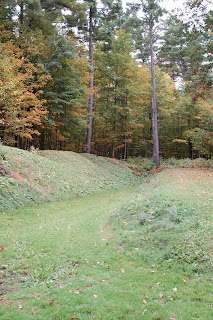Looking back at all the visits we made to Fort Ticonderoga between 1950 and 1980, I now feel the role of the French in designing, building and defending the fort was always overshadowed by its smaller role as an American fort captured from the British by Benedict Arnold, Ethan Allen, and the Green Mountain Boys at the start of the War of American Independence. This was partially the design of the Pell family who bought the fort when it was in ruins and restored it to its former grandeur.
 |
| Literature about the Fort circa 1976 American Bicentennial Year |
The Pell family wanted to glorify American independence and British American culture. This was very fashionable at the beginning of the 20th century. And by the time I came along in the 1950s, visiting the fort was more about the defeated Black Watch and Benedict Arnold's short stay rather than Samuel Champlain or Marquis de Montcalm who won a dramatic victory at Carillon over the English. The Scottish Black Watch regiment got the positive spin and so too did Benedict Arnold and the patriots.
 |
| Monument to the Black Watch |
History belongs to the victors. But what was the big deal about Arnold anyway? When Arnold and Allen stormed the fort no one was home but a few pantless British guards depicted in white cotton nightshirts stunned by Allen's thunder "in the name of the Great Jehovah and the Continental Congress". When the Pell family opened the restored fort in 1909, the 300th year anniversary of Samuel Champlain's travels to that lake, there was a grand celebration that included the president of the United States, Howard Taft. The program celebrated the American victory and domination; there was little in the festivities remembering the French and French Americans who built the fort and the natives peoples who lived and traded in the vicinity before Europeans.
Illustrating this BritishAmerican bias is a copy of an early information brochure, below, that describing the fort's history and its French period as "Fort Carillon, a threat, a challenge, a sinister thing, a weight on the hearts of the colonialists, came into being."
British American centrism has changed over the years- somewhat! Now French regimental colors flyover the stone fort. The French earthworks and the dedication to the French regiments of the French and Indian War along the roadway into the fort testify to the presence of the French before the English captured it
In truth, Fort Ticonderoga was Fort Carillon and it was built by the French during the French and Indian War. The Milot, Beauvais, Delmas, Cassagrain anDuboard dit Chaumont forefathers who fought in that conflict are featured in Fathers Who Fought in the French and Indian War. There is a high probably many of these men, our forefathers, were involved in the construction and defense of Fort Carillon under General Montcalm.
 |
| Defenses built by the French Regiments |

 |
| Battle Plan |
 |
| French Trenches |
Here is a list of stories on this blog about the forts in the Champlain-Richelieu Valleys:









I am wondering if you have come across any drawings or text which describes the construction of fort Carillon. I have heard that the walls of the fortress (not the buildings inside) actually had a foundation in stone but that the upper part was wood, and that they were wrongly renovated all in stone.
ReplyDelete